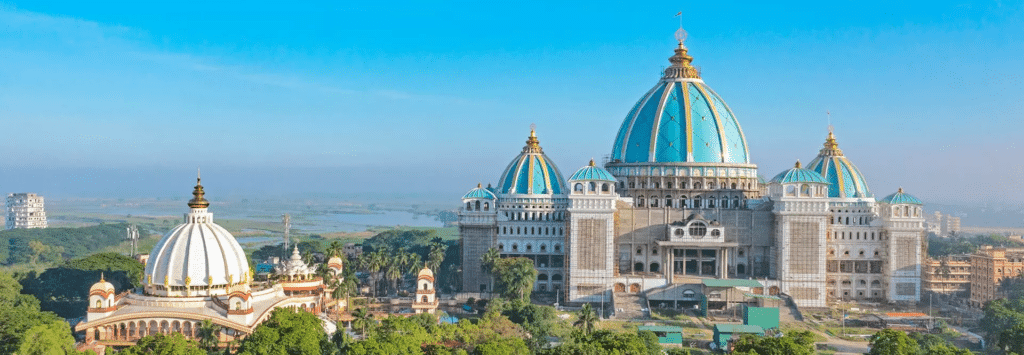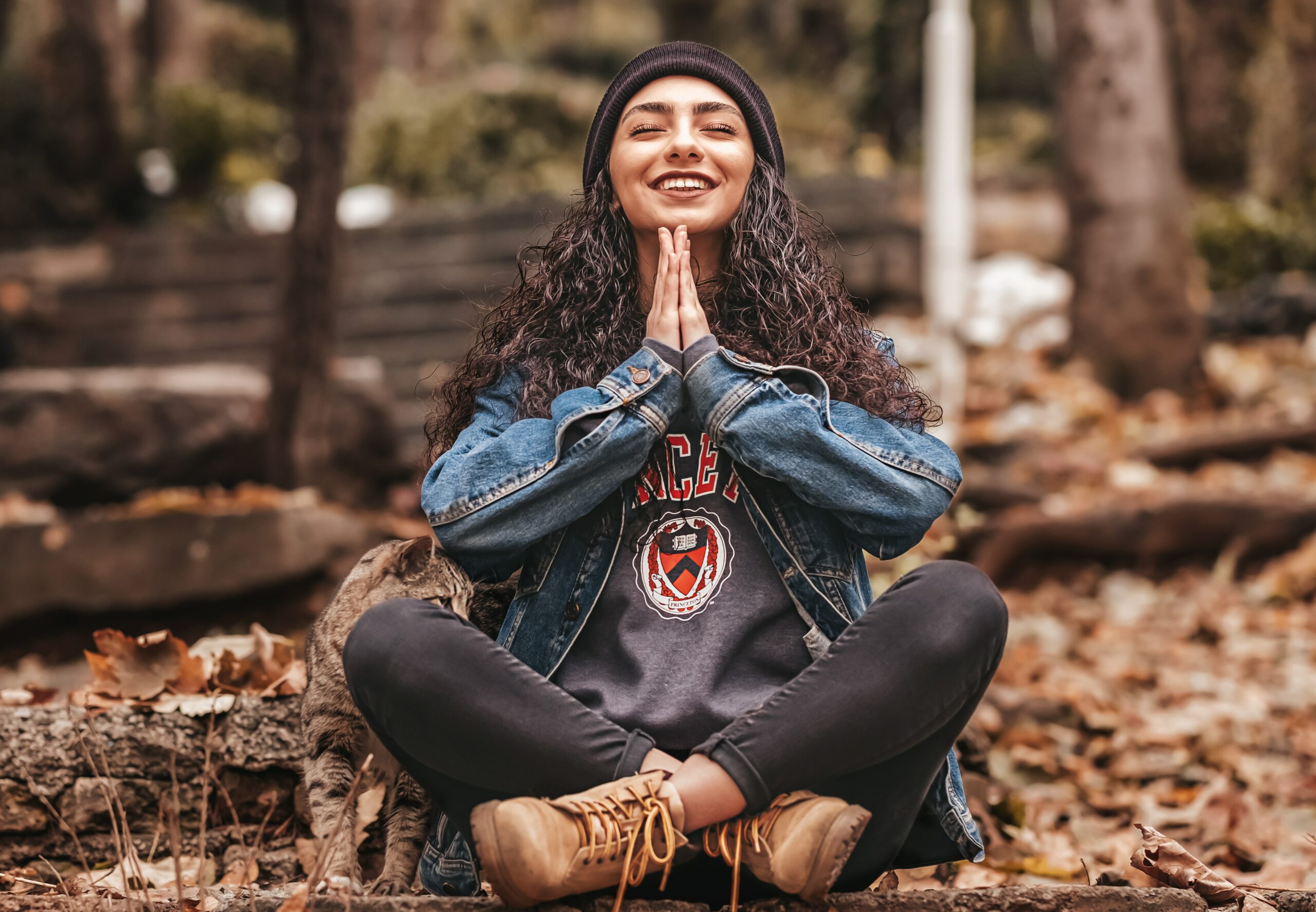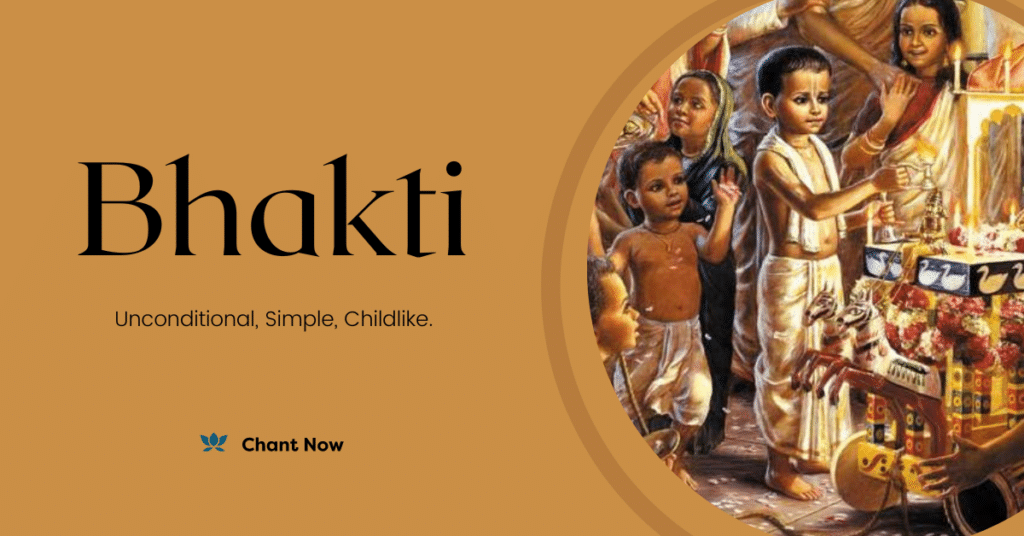A Day in the Life of a Bhakti Yogi

Ever wonder what a regular day for Bhakti Yoga practitioners is like? What do they do? How they live? Today, we’ll look at a typical day in the life of Urugaya Das, a Bhakti Yogi from Sydney, who has been living in Mayapur Dham for over 5 years now with his wife Lalita who is from Mauritius.
Mayapur Dham, located in West Bengal, India, is a spiritual haven and the birthplace of Sri Chaitanya Mahaprabhu, the 16th century mystic saint who appeared like a cloud burst of Krishna Bhakti. and He rained so much loving devotion on the world that more than 5 centuries later, millions of people from around the world continue to be drenched in the shower of his loving mercy and limitless compassion.
More than 10,000 Bhakti Yogis from across 30 different countries have taken up residence in this sacred place, where the air is filled with devotion, and life revolves around the pursuit of spiritual growth and service to God and humanity. Urugaya and Lalita are amongst them. So let’s get right into it and see how their day begins!
Morning Meditation and Chanting:
As the first rays of the sun gently caress the horizon over the Jalangi river which flows just 100 metres away from their home, Uru and Lalita are already up. While Uru goes to the river for a morning dip, Lalita is getting ready at home before Uru comes back and they both sit together for Japa, a form of meditative chanting of the Hare Krishna mahamantra.
The repetitive recitation of the mantra acts as a powerful spiritual tool, calming the mind and nurturing the soul. We use one bead on the japa mala, a string of prayer beads, count one maha-mantra. As they chant together, settling into a harmonious rhythm, they try to withdraw their senses from the external world and direct their consciousness to the transcendental sound of the mantra, invoking the divine presence, praying for a deeper connection, for service, and for the fulfilment of their cherished spiritual desires.
This tranquil period of prayer and reflection and meditation allows for inner clarity and sets the tone for the day ahead.
Visiting the Temple:
It’s 7! Their morning japa is complete and it’s time to head to the temple, where the heart of the spiritual community beats with devotion. The temple is already adorned with vibrant colors, fragrant flowers, and resounding melodies of devotional music can be heard as over a thousand devotees pour in to have a glimpse of their beloved deities – Sri Sri Radha Madhava, Pancattatva and Narsimhadeva. The worship begins with the communal singing of deeply devotional prayers and offering of various items of worship such as incense, flowers, lamp etc. in an elaborate and intricate ceremony and concludes with offering prayers and paying homage by bowing down in front of the seated figure of Srila Prabhupada, the founder of the worldwide Hare Krishna movement and spiritual preceptor of its members.
Study and Reflection:
The Bhakti Yogi dedicates a portion of their day to study and reflection, delving into the profound teachings of the Bhagavad Gita, Srimad Bhagavatam, and other sacred scriptures. These timeless texts provide guidance, wisdom, and insight into the nature of the soul and its relationship with the divine. Various senior monks and devotee practitioners who have dedicated their lives in the pursuit of self-realisation conduct one-hour classes every day on various topics once the morning worship has concluded.
Today’s class is on the “Yoga Ladder” as described by Krishna in the Bhagavad Gita to Arjuna. The speaker is one of the senior most monks in the community, known for his academic scholarship as well as exemplary life and character. Uru and Lalita listen with rapt attention as he speaks about the various stages of self-realisation starting from Brahman, Paramatma and Bhagavan and the advancement of spiritual aspirants from material activities to Karma Yoga to Jnana Yoga through finally to Bhakti Yoga. It’s a very interesting class and a throng of devotees gather around the monk after the class has concluded to discuss further and others head out for the start of their daily duties.
Time for Service!
Selfless service, known in Sanskrit as Seva, is an integral part of every Bhakti Yogi’s life. Uru and Lalita are no different. They lead a community service program which involves cooking and distributing sanctified vegetarian meals for the devotees and residents of the villages surrounding the temple. Besides this, Uru teaches Bhakti Yoga and conducts various classes and workshops online where he mentors a community of aspiring Bhakti Yogis and individuals interested in Bhakti Yoga, mantra meditation and spirituality spread around the world. Lalita is a graphic design artist, painter and creator, who uses her talents to create beautiful dresses, paraphernalia and decorations for the deities and the temple.
For them, their seva is the most tangible and powerful means of connecting with the divine through the act of serving others and helping the community. They say it helps them remain humble, to feel motivated and grow as individuals. Engaging their creativity, energy and skills for a purpose larger than then mere individual subsistence, and ultimately to find deep fulfilment and satisfaction which comes with living a life aligned with their highest values and ideals.
Prasadam
Its 2 in the afternoon and Uru and Lalita have an invitation for lunch over at their friend’s place, a much welcome break since they have been hard at work since 9. Being invited for lunches or dinners is an everyday occurrence for the devotees in this tight knit community. It’s like living in one big family and there is always someone or something to celebrate and be thankful about and what better way to share it with everyone than over hot plates of khichri, pakoras, curries, pickle, yoghurt, papadam and cheesecake which is the menu for today’s lunch feast! Everyone sits on the floor, legs crossed, with green banana leaves serving as a plate, serving each other ladles full of the delicious sanctified vegetarian fare which had been lovingly prepared and offered to the Lord. A quick prayer before everyone digs in and eats to their hearts content!
Prasadam is a very important part of life in Mayapur and you would be hard pressed to find anyone who holds back when it comes to partaking the delicacies which are on offer. Being surrounded by lush agricultural fields and farms, there is an abundance of fresh organic produce and spices. Combine that with Bengal’s extraordinary culinary tradition and cooking being a prized skill in the service of the deities, many if not most devotees are excellent cooks and standard of Prasadam here is literally divine! The lunch over, it time for a nap before the evening Arati followed by the Kirtan program.
Evening Arati:
As the sun sets, Uru and Lalita return to the temple along with thousands of other devotees, both residents of Mayapur and pilgrims who have come from outside for a visit, for the evening arati. A captivating ceremony of offering lamps, incense, and prayers to the deities. The flickering flames dance in synchronization with the melodious chanting, creating a mystical ambiance that elevates the spirit and deepens the sense of connection with the divine, setting the mood for what is to follow!
Kirtan:
Every Bhakti Yogi understands and truly appreciates the importance of community and satsang, or spiritual association. Throughout the day, they engage in uplifting interactions with fellow devotees, sharing insights, discussing spiritual topics, and providing support and encouragement on the spiritual path. However, it is during these evening Kirtans that everyone leaves behind any inevitable worries and challenges and comes together to participate in Kirtan, the congregational chanting and singing of the Hare Krishna mahamantra.
The atmosphere is surcharged with enthusiasm, joy, camaraderie, and a pure spiritual ecstasy. Kirtaniyas tune and prep their instruments. The singer is on the harmonium. The mridanga players make sure the bass and treble are on point and can handle any rhythm, tempo, speed, intensity and mood that the singer wants to create. The kartala players keep perfect time and create the syncopation that glues the whole effort together.
The Kirtan starts slow, contemplative, and meditative. Deep soulful melodies in prayer and glorification of the divine set the stage for what is to follow. The singer picks up pace. The beats of the mridanga become faster and louder. The call and response both become more animated. No one is able to sit still anymore beginning to move and sway as if involuntarily. One by one, the devotees begin to stand up and start moving and dancing. Soon, the whole temple resembles a divine playground. Everyone loses their inhibitions and surrenders themselves to the divine play. Old and young, children and adults, rich and the poor, the learned and the illiterate, the mighty and the meek, the desolate destitute and the celebrated hero, every designation, every label, every societal construct, every divide, melts away. What remains is simply the divine and the devotee, dancing together with hearts overcome, in an explosion of emotions and a flood of feelings.
This was a glimpse into the life of Urugaya and Lalita. In the middle of it all, happily lost, steeped in the various shades of divine love, two colourful strands in this infinite tapestry that is Krishna Consciousness. Hope they are able to rest a little before beginning yet another day tomorrow!






